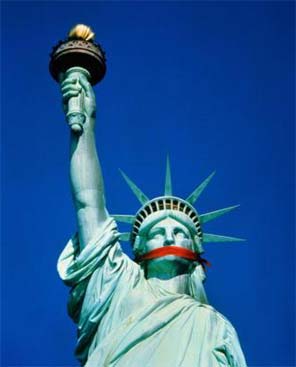 The recent FBI arrests of animal rights activists as “terrorists†for chalking sidewalks, protesting and making fliers marks a drastic turning point in the Green Scare, and in the history of this country. The government and corporations are clearly hoping to set a legal precedent for the sweeping power of the Animal Enterprise Terrorism Act. But these arrests are much more than a test case, or an isolated incident of ambitious prosecution.
The recent FBI arrests of animal rights activists as “terrorists†for chalking sidewalks, protesting and making fliers marks a drastic turning point in the Green Scare, and in the history of this country. The government and corporations are clearly hoping to set a legal precedent for the sweeping power of the Animal Enterprise Terrorism Act. But these arrests are much more than a test case, or an isolated incident of ambitious prosecution.
These arrests are part of a 5-step process the FBI and other government agencies are using to overtly label First Amendment activity as “terrorism.â€
The process has worked something like this:
- Label. The first step was to label illegal direct action by groups like the Animal Liberation Front and Earth Liberation Front as “terrorism.†The FBI, corporations, industry groups and politicians began doing this in the 1980s, through media campaigns, think tank reports and legislation like the Animal Enterprise Protection Act.
- Guilt by association. Next, these groups expanded their smear campaign to anyone who ideological supports direct action and economic sabotage. They began labeling the above-ground supporters of those movements as “terrorists.†A turning point was the conviction of the SHAC 7 for running a controversial website that vocally supported a wide range of tactics.
- More guilty by association. This is now. The guilt by association is spreading from those who vocally support direct action (and, like the SHAC 7, perhaps even publish anonymous communiqués) to those who are merely lawfully protesting as part of the same campaign. In the SHAC 7 case, the government argued that the defendants were “conspiring†to promote illegal activity by running a website. In these recent arrests, the government is arguing that the First Amendment activity itself is “terrorism†because it’s part of a campaign that involves illegal tactics.
- Expand the net. With the latest arrests, the government is still trying to play up the fact that illegal actions have happened recently in California, including bombings that have been recklessly attributed to animal rights activists. The next step is to completely drop that pretext. In other words, the next step is to go after people who are using their First Amendment rights and are not engaging in home protests, chalking sidewalks or wearing masks. This is the same expansion of the net that happened during the Red Scare: targeting writers, speakers, journalists, and public figures. I feel strange writing this but, in many ways, the next step is to go after people like me.
- Repeat. This process will be repeated for different organizations and different types of people (activists, non-profit leaders, writers) and it will be repeated for other social movements. The government is not establishing these legal and legislative precedents simply to abandon them once the animal rights “radicals†are imprisoned. The legal latticework will be used against the next social movement, and the next, and the next. This has happened in every era of government repression throughout history: once those in power discover tools for silencing one opposition group, they never stop there.
In analyzing a process like this, it should be very clear that I don’t mean to imply, in any way, that this process is inevitable. The FBI is formulaic in how it cracks down on protest movements—we can see the patterns throughout U.S. history. The responses of activists and everyday people, though, need not follow any formula. The future is fluid. We have the power to intervene in this process—through education, community building, media outreach, lobbying, and the courts—and we must do so immediately, swiftly, and forcefully.